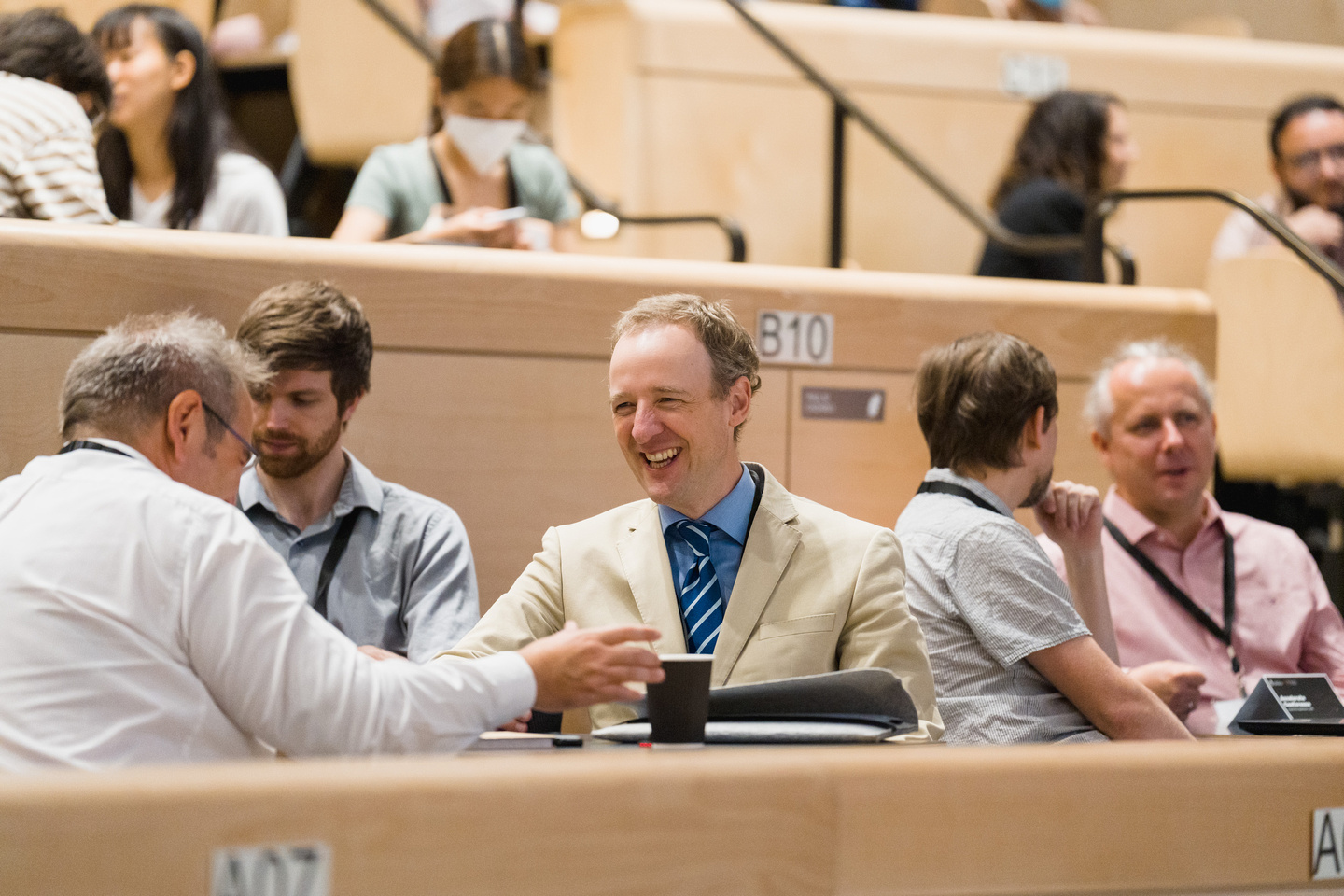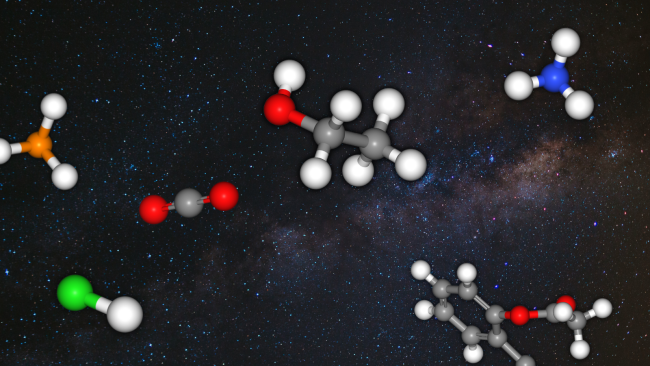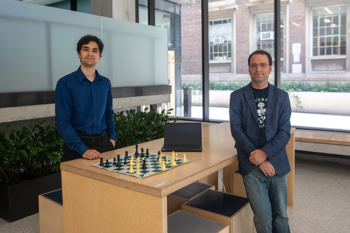Professor Anatole von Lilienfeld (Chemistry, MSE) navigates space — but rather than exploring the depths of the universe, his work is here on Earth in “chemical space.”
And instead of hunting for unknown stars, galaxies and other celestial objects, his focus is on the untapped potential of undiscovered chemical combinations. To do this work, he is not equipped with a powerful telescope — his tool of choice is artificial intelligence (AI).
Von Lilienfeld is the inaugural Clark Chair in Advanced Materials at the Vector Institute and the University of Toronto, and a pivotal member of U of T’s Acceleration Consortium (AC). Appointed jointly to the Department of Chemistry in the Faculty of Arts & Science and the Department of Materials Science & Engineering at U of T Engineering, he is a leading expert on the use of computers to understand the vastness of chemical space.
Von Lilienfeld, who was recently named a Canada CIFAR AI Chair, was a speaker at the AC’s first annual Accelerate conference last month at U of T.
This four-day program centred around the power of self-driving labs (SDLs), an emerging technology that combines AI, automation, and advanced computing to accelerate materials and molecular discovery. The Accelerate conference brought together over 200 people and featured talks and panels with more than 60 experts from academia, industry, and government who are shaping the emerging field of accelerated science.
Erin Warner, communications specialist at the Acceleration Consortium, recently spoke with von Lilienfeld about the conference and the digitization of chemistry.
How big is ‘chemical’ space?
We are surrounded by materials and molecules. Consider the chemical compounds that make up our clothing, the pavement we walk on, and the batteries in our electric cars. Now think about the new possible combinations that are out there waiting to be discovered, such as catalysts for effective atmospheric CO2 capture and utilization, low-carbon cement, lightweight biodegradable composites, membranes for water filtration, and potent molecules for treatment of cancer and bacterial-resistant disease.
In a practical sense, chemical space is infinite and searching it is no small feat. A lower estimate says it contains 1060 compounds — more than the number of atoms in our solar system.
Why do we need to accelerate the search for new materials?
Many of the most widely used materials no longer serve us. Most of the world’s plastic waste generated to date has not yet been recycled. But the materials that will power the future will hopefully be sustainable, circular and inexpensive.
Conventional chemistry is slow, a series of often tedious trial and error that limits our ability to explore beyond a small subset of possibilities. However, AI can accelerate the process by predicting which combinations might result in a material with the set of desired characteristics we are looking for (e.g., conductive, biodegradable, etc.).
This is but one step in self-driving laboratories, an emerging technology that combines AI, automation, and advanced computing to reduce the time and cost of discovering and developing materials by up to 90%.
How can human chemists and AI work together effectively?
AI is a tool that humans can use to accelerate and improve their own research. It can be thought of as the fourth pillar of science. The pillars, which build on each other, include experimentation, theory, computer simulation and AI.
Experimentation is the foundation. We experiment with the aim of improving the physical world for humans. Then comes theory to give your experiments shape and direction. But theory has its limitations. Without computer simulation, the amount of computation needed to support scientific research would take far longer than a lifetime. But even computers have constraints.
With difficult equations come the need for high-performance computing, which can be quite costly. This is where AI comes in. AI is a less costly alternative. It can help scientists predict both an experimental and computational outcome. And the more theory we build into the AI model, the better the prediction. AI can also be used to power a robotic lab, allowing the lab the ability to run 24/7. Human chemists will not be replaced; instead, they can hand off tedious hours of trial and error to focus more on designing the objectives and other higher-level analysis.

Are there any limitations to AI, like the ones you described in the other pillars of science?
Yes, it is important to note that AI is not a silver bullet, and that there is a cost associated with it that can be measured in data acquisition. You cannot use AI without data. And data acquisition requires experimenting and recording the outcome in a way that can be processed by computers. Like a human, the AI then learns by reviewing the data and making an extrapolation or prediction.
Data acquisition is costly, both financially and in terms of its carbon footprint. To address this, the goal is to improve the AI. If you can encode our understanding of physics into the AI, it becomes more efficient and requires less data to learn but provides the same predictive qualities. If less data is needed for training, then the AI model becomes smaller.
Rather than just using AI as a tool, the chemist can also interrogate it to see how well its data captures theory, perhaps leading to the discovery of a new relative law for chemistry. While this interactive relationship is not as common, it may be on the horizon and could improve our theoretical understanding of the world.
How can we make AI for discovery more accessible?
The first way is open-source research. In the emerging field of accelerated science, there are many proponents of open-source access. Not only are journals providing access to research papers, but also in many cases to the data, which is a major component for making the field more accessible. There are also repositories for models and code like GitHub. Providing access could lead to scientific advancements that ultimately benefit all of humanity.
A second way to expand AI for discovery is to include more students. We need to teach basic computer science and coding skills as part of a chemistry or materials science education. Schools around the world are beginning to update their curricula to this effect, but we still need to see more incorporate this essential training. The future of the sciences is digital.
How do initiatives like Acceleration Consortium, and a conference like Accelerate, help advance the field?
We are at the dawn of truly digitizing the chemical sciences. Coordinated, joint efforts, such as the Acceleration Consortium, will play a crucial role in synchronizing efforts not only at the technical but also at the societal level, thereby enabling the worldwide implementation of an ‘updated’ version of chemical engineering with unprecedented advantages for humanity at large.
The consortium also serves to connect academia and industry, two worlds that could benefit from a closer relationship. Visionaries in the commercial sector can dream up opportunities, and the consortium will be there to help make the science work. The groundbreaking nature of AI is that it can be applied to any sector. AI is on a trajectory to have an even greater impact than the advent of computers.
Accelerate, the consortium’s first annual conference, was a great rallying event for the community and was a reminder that remarkable things can come from a gathering of bright minds. While Zoom has done a lot for us during the pandemic, it cannot easily replicate the excitement and enthusiasm often cultivated at an in-person conference and which are needed to direct research and encourage a group to pursue a complex goal.
What area of ‘chemical space’ fascinates you the most?
Catalysts, which enable a certain chemical reaction to occur but remain unchanged in the process. A century ago, Haber and Bosch developed a catalytic process that would allow the transformation of nitrogen — the dominant substance in the air we breathe — into ammonia. Ammonia is a crucial starting material for chemical industries, but also for fertilizers. It made the mass production of fertilizers possible and saved millions of people from starvation. Major fractions of humanity would not exist right now if it were not for this catalyst.
From a physics point of view, what defines and controls catalyst activity and components are fascinating questions. They might also be critical for helping us address some of our most pressing challenges. If we were to find a catalyst that could use sunlight to turn nitrogen rapidly and efficiently into ammonia, we might be able to solve our energy problem by using ammonia for fuel. You can think of the reactions that catalysts enable as ways of traveling through chemical space and to connect different states of matter.



